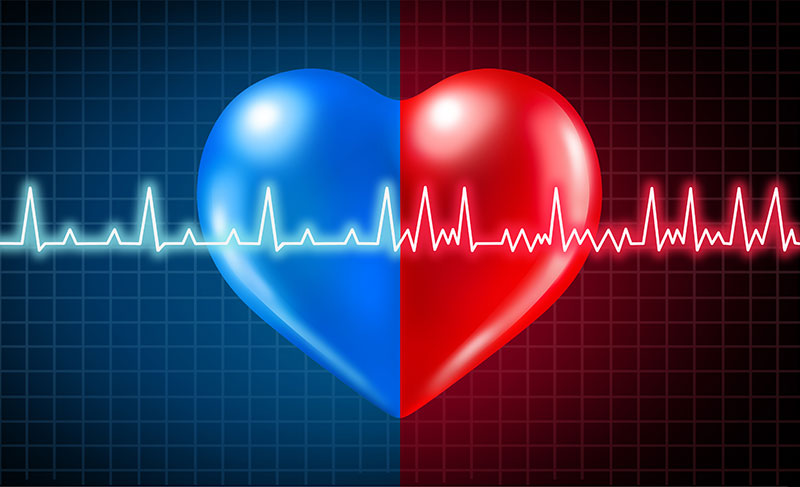
Blood pressure measures the force that the heart uses to pump blood around the body, and it can go up and down throughout the day and night according to activity level. If, however, blood pressure readings remain at a consistently abnormal level, it can indicate a problem, which, if left untreated, can lead to potentially life-threatening medical conditions.
We all require a certain amount of pressure to successfully move blood around the body. Normally, blood pressure rises during the day when we’re moving about or exercising, and when we’re resting or sleeping, it usually drops, which reduces the strain on the cardiovascular system.
How Is Blood Pressure Measured?
Blood pressure is determined by measuring systolic and diastolic blood pressure readings, and it is measured in millimeters of mercury (mmHg). Systolic blood pressure measures the force at which the heart exerts on the walls of the arteries each time it contracts (beats) – when pressure is at its highest. Diastolic blood pressure measures the force your heart exerts on the walls of the arteries when the heart rests between beats – when pressure is at its lowest.
The reading is recorded as two numbers – systolic pressure is the higher number and diastolic pressure is the lower number. Readings fall into four general categories, which range from normal to stage 2 high blood pressure. To get an accurate blood pressure measurement, your family medicine provider will evaluate your blood pressure readings based on the average of two or more blood pressure readings. Ranges can vary depending on age and other factors, but as a general guide, the readings are as follows:
- Normal blood pressure, which has a systolic reading of less than 120 and a diastolic reading of less than 80
- Prehypertension – 120-130 (systolic) and 80-89 (diastolic)
- High Blood Pressure stage 1 – 140-159 (systolic) and 90-99 (diastolic)
- High Blood Pressure stage 2 – 160 or higher (systolic) and 100 or higher (diastolic)
Low blood pressure (hypotension), which is much less common, is considered as 90 or lower (systolic) and 60 or lower (diastolic). It can be caused by certain medications, medical conditions such as diabetes, pregnancy, or an underlying condition such as heart failure or dehydration. Low blood pressure requires further investigation, and treatment will depend on the cause.
High Blood Pressure
High blood pressure, also known as hypertension, means blood pressure is consistently too high – even when resting, and means the heart has to work hard to pump blood around the body. High blood pressure is often termed as the “silent killer,” because it doesn’t always present noticeable symptoms but can cause significant cardiovascular and organ damage and increase your risk of life-threatening health complications. High blood pressure can cause progressive damage to blood vessels by causing them to become rigid or narrow. This makes it easier for fatty material, known as atheroma, to build up in them, which, in severe cases, can lead to a heart attack or stroke.
What Causes High Blood Pressure?
There isn’t always an exact cause of high blood pressure. It can be related to unhealthy lifestyle habits including smoking, drinking too much alcohol or caffeine, being overweight, not exercising enough, and consuming too much salt.
Secondary hypertension is caused by another medical condition, such as kidney disease, adrenal gland tumors, coarctation of the aorta (a narrowed aorta from birth), pregnancy, and thyroid dysfunction. Often, if the source of secondary hypertension is treated, blood pressure can return to normal.
Risk of high blood pressure can increase if you are over 65, have a close blood relative with high blood pressure, have a medical condition such as diabetes, or due to certain medications such as birth control pills.
Diagnosing and Treating High Blood Pressure
Without symptoms, people can have high blood pressure for years without even realizing. The only way to diagnose high blood pressure is to have it measured – usually with a blood pressure cuff, which is a quick and painless process. A blood pressure cuff is positioned around your arm and inflated. As air in the cuff is released, a stethoscope is used to listen to the pulse. Pressure is recorded as blood returns to the arm. It is then classified as normal, prehypertension, or high.
Further tests to check your organs for damage may be requested, which may include blood or urine tests, an eye exam, imaging tests, or specific tests to detect heart or blood vessel damage.
Treatment for high blood pressure primarily consists of lifestyle changes (such as weight loss, exercise, and dietary changes) and medications to bring it back within a normal range and reduce the risk of life-threatening conditions.
Quality Primary Care in Wellington and Royal Palm Beach, Florida
If you are concerned about your blood pressure, speak to the compassionate primary care providers at Advanced Medical in Wellington and Royal Palm Beach, Florida. At Advanced Medical, we diagnose and treat high blood pressure along with many other medical conditions and urgent care needs.
To learn more about our services, or to arrange an appointment, call us today at (561) 434-1935 or you can request an appointment online.

